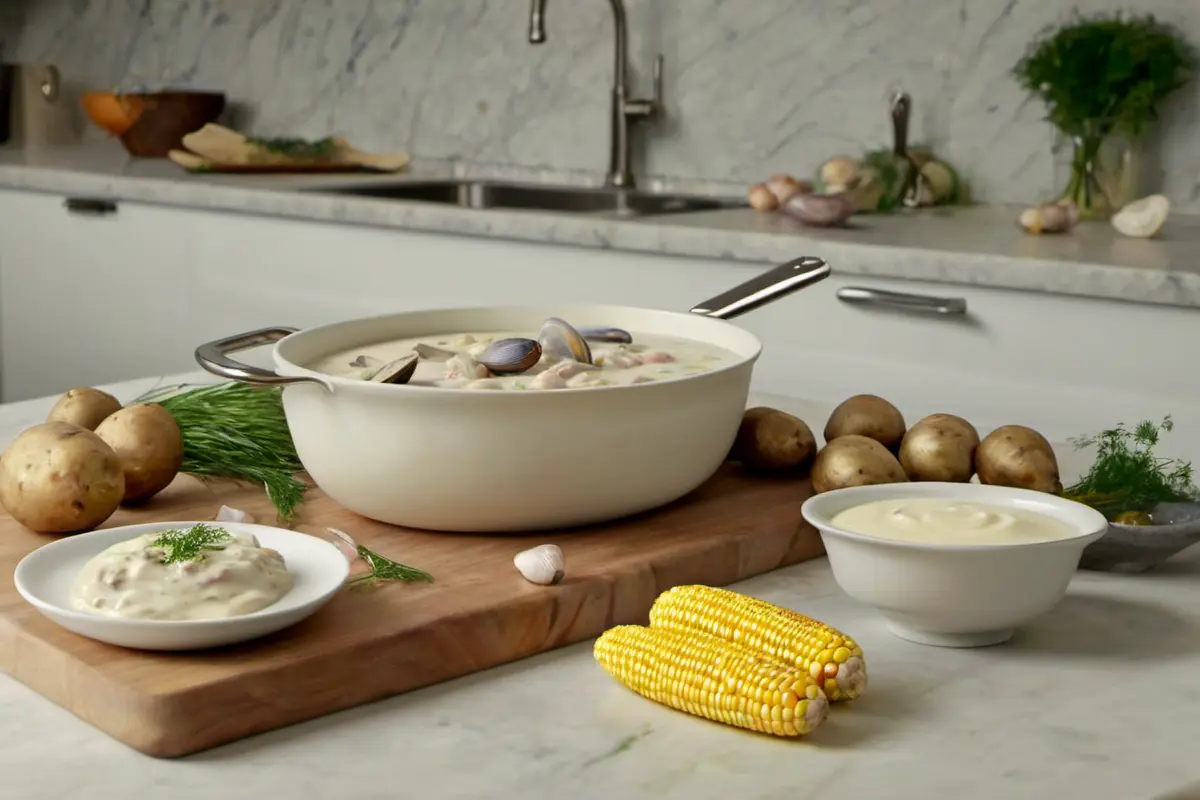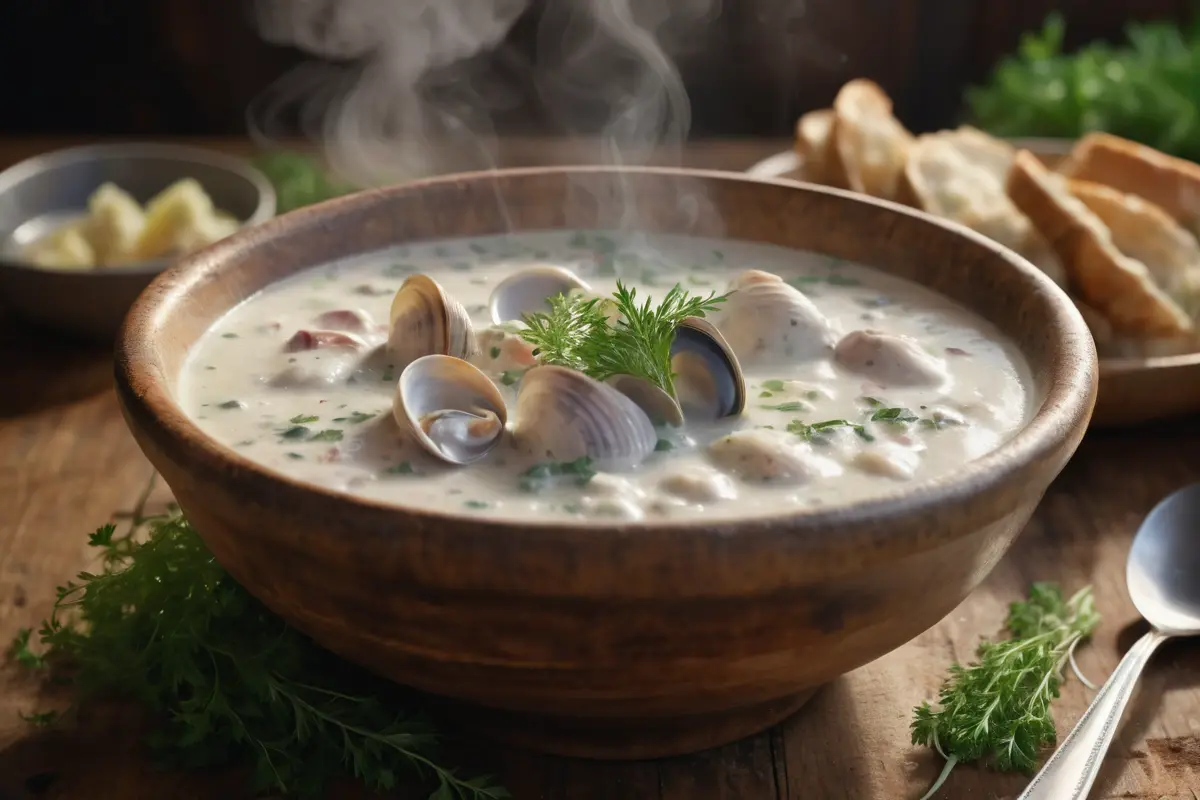When pondering what makes a chowder not a soup, we dive into a culinary discussion rich with history and flavor. Indeed, chowders stand apart with their thick, creamy bases and hearty ingredients, setting them distinctly apart from the broader category of soups. This article will unravel the essence of chowder, exploring why it’s not just any soup but a comforting dish with deep regional roots and varied ingredients.
Introduction to Chowders
Defining Chowder: Beyond a Simple Soup
Chowders are, without a doubt, a standout in the realm of comfort foods. So, what makes a chowder not a soup? It all starts with the base. Unlike the often light and brothy nature of soups, a chowder features a rich, creamy foundation that hugs every spoonful. Typically, this base includes milk or cream, which imparts a velvety texture that is instantly recognizable.
Moreover, chowders are cooked with a generous hand when it comes to chunky ingredients. From the succulent clams of a New England Clam Chowder to the robust vegetables in a Corn Chowder, the pieces are not merely an addition; they are the stars. This heartiness makes chowders particularly filling and satisfying, a meal in itself.
The Historical Significance of Chowder
The story of chowder is as rich as its consistency. Originating from the fishing villages of Europe, chowder found its way to North America, where it became a staple in maritime provinces and the northeastern United States. Each region has put its twist on the classic, adapting the ingredients to what’s locally available and embedding it into the cultural fabric of their food traditions. For a deeper dive into this history, read more about the four centuries of chowder and its development in New England.
Furthermore, the history of chowder is peppered with tales of community and simplicity. Traditionally, it was a dish that brought people together, cooked in large pots to feed a crowd. This communal aspect highlights the cultural significance of chowder beyond its physical ingredients.
Thus, understanding what makes a chowder not a soup involves more than tasting—it’s about experiencing a dish steeped in tradition and community. As we delve deeper into the differences between chowder and soup, remember, it’s not just about what’s in the bowl, but the stories it tells and the warmth it brings to the table.
In the next part, we’ll explore the core differences between chowder and soup, highlighting how ingredients, preparation, and regional influences craft a dish uniquely distinct from its culinary cousins.
Continuing our flavorful exploration of what makes a chowder not a soup, we delve into the specific characteristics that distinctly set chowders apart. Each element—from the base to the ingredients and the texture—plays a crucial role in defining a chowder’s unique identity.
Core Differences
The Base Difference: Creamy vs. Broth
One of the fundamental differences lies in the base. Whereas soups may use a variety of broths, from chicken to vegetable, chowders almost always rely on a creamy base. This base typically involves milk, cream, or even a roux to create a thick, rich texture that envelops every ingredient in the pot. It’s this creamy consistency that makes chowders so indulgent and satisfying.
Ingredients: What Goes into a Chowder?
When considering what makes a chowder not a soup, the choice of ingredients is pivotal. Chowders are hearty and substantial, often featuring main ingredients like seafood or a variety of chunky vegetables. For instance, in clam chowder, a classic variety, chefs load tender clams, potatoes, onions, and sometimes bacon. They select each ingredient to stand out, contributing to the overall heartiness of the dish.
Furthermore, cooks do not just throw the ingredients in chowder together; they prepare them thoughtfully to enhance the dish’s depth of flavor. For example, they commonly sauté onions and bacon before adding them to the pot to unlock their full flavor potential, thus enriching the chowder’s profile.
Consistency and Texture: Thick vs. Light
Chowders are characteristically thicker than soups. This thickness is often achieved through the addition of thickeners such as flour or cornstarch. Moreover, some recipes call for mashing some of the potatoes in the chowder to add to the creamy texture. This approach to consistency ensures that each spoonful is robust and filling, making chowder more of a meal than a simple appetizer.
Regional Variations and Their Impact
Chowders reflect their regional origins, with local ingredients influencing their flavors and textures. For instance, the New England Clam Chowder is known for its use of local clams and dairy, while the Manhattan Clam Chowder stands out with its tomato-based broth, offering a tangier taste profile. These regional twists not only highlight the versatility of chowder but also how deeply it is woven into the culinary tapestry of its region. Learn more about the origins of specific chowder types, including corn chowder, on Cookery Gems.
By understanding these core differences, it becomes clear what makes a chowder not a soup—it is a complex dish with deep roots in tradition and regional cuisine. In the following sections, we will explore the varieties of chowders and how they are prepared, further showcasing the diverse world of this beloved dish.
As we continue to explore the rich world of chowders, let’s delve into the various types that showcase the diversity and creativity inherent in this beloved dish. Each type of chowder offers a unique twist, demonstrating just how versatile and adaptable this hearty dish can be. The table below provides a quick comparison of different chowder types, highlighting their bases, key ingredients, and typical seasonings used.

Exploring Chowder Varieties
| Type of Chowder | Base | Key Ingredients | Typical Seasonings |
|---|---|---|---|
| New England Clam | Creamy, milk-based | Clams, potatoes, onions, bacon | Thyme, black pepper |
| Manhattan Clam | Tomato-based | Clams, potatoes, onions, celery | Bay leaves, thyme |
| Corn Chowder | Creamy, milk-based | Corn, potatoes, bell peppers | Paprika, black pepper |
| Vegetable Chowder | Creamy, plant-based | Various seasonal vegetables | Thyme, bay leaves |
| Fish Chowder | Creamy, milk or cream | Mixed local fish, potatoes | Dill, parsley |
| Poultry Chowder | Creamy, milk-based | Chicken or turkey, corn, celery | Sage, thyme |
Clam Chowder: The Quintessential Favorite
When pondering what makes a chowder not a soup, clam chowder often comes to mind as the epitome of this dish. New England Clam Chowder, known for its creamy, thick base and generous portions of clams and potatoes, is perhaps the most iconic. This chowder is a testament to simplicity and flavor, often seasoned with thyme and pepper, and sometimes enriched with bacon for a smoky undertone. For further historical context, explore a brief history of clam chowder across various regions.
On the other hand, Manhattan Clam Chowder offers a stark contrast with its tomato-based broth, giving it a distinctly tangy and less creamy texture. This version incorporates a similar array of vegetables and clams but stands out with its bold, vibrant flavor.
Corn and Vegetable Chowders
Not all chowders rely on seafood. Corn chowder is a popular variant that highlights sweet corn as the star ingredient, often paired with bell peppers, potatoes, and onions. This type of chowder is typically lighter but still maintains the thick, creamy consistency characteristic of chowder. It’s a perfect example of how chowder adapts to vegetarian preferences while retaining its comforting essence.
Vegetable chowder further expands the category, incorporating a medley of seasonal vegetables. This type allows for creativity, blending various textures and flavors into a hearty, satisfying dish that appeals to a broad audience, including those looking for plant-based options.
Lesser-Known Chowders: Fish and Poultry
While clam and corn are familiar stars in the chowder scene, fish and poultry chowders bring their unique tastes to the table. Fish chowder often uses a mix of available local fish, creating a deep, savory flavor profile that resonates with seafood lovers. Poultry chowder, less common but equally delicious, utilizes chicken or turkey, offering a lighter but equally creamy alternative to seafood-based recipes.
These chowders, whether based on seafood, corn, or poultry, illustrate the incredible versatility of the dish. They show that chowder is not merely a soup; it is a canvas for culinary expression, adaptable to different ingredients and regional tastes. As we move forward, we will explore the practical aspects of making chowder, providing tips on how to achieve the perfect balance of flavors and textures in your own kitchen.
As we delve into the practical aspects of making chowder, it’s important to recognize the techniques and considerations that contribute to crafting the perfect bowl. Making chowder is an art that requires attention to detail, from the selection of ingredients to the final simmer.
Preparing Chowders
Key Techniques for Perfect Chowder
Creating an exceptional chowder begins with the foundation—the base. For creamy chowders, starting with a roux (a mixture of flour and fat) can make all the difference. This not only thickens the chowder but also adds a silky texture that’s crucial for that comforting mouthfeel. Slowly whisking in milk or cream ensures that the base remains smooth and free of lumps.
Next, the sequence in which ingredients are added plays a critical role. For instance, adding the potatoes and other hearty vegetables early allows them to soften and release their flavors into the broth, enriching the overall taste. Conversely, delicate ingredients like seafood should be added towards the end of cooking to prevent them from overcooking and becoming tough.

Common Mistakes to Avoid
One of the frequent missteps in chowder making is rushing the cooking process. Chowders benefit from a slow, gentle simmer that allows flavors to meld beautifully. Boiling aggressively can cause dairy-based chowders to curdle and break, compromising their creamy texture.
Another common error is underseasoning. Chowder needs a generous hand with seasonings to bring out the rich flavors of the ingredients. It’s essential to taste as you go and adjust the seasonings, particularly salt, pepper, and herbs, to ensure a well-balanced dish.
Also, be mindful of the thickness. While chowder should be hearty and thick, over-thickening can turn it into a gloppy mess. It’s important to achieve the right balance, using just enough thickener to give body without overshadowing the natural textures of the ingredients.
Understanding these techniques and pitfalls can elevate your chowder from good to great, showcasing your culinary skills and ensuring every bowl is a comforting experience. As we continue, we’ll consider the nutritional aspects of chowder, helping you make choices that align with health-conscious eating while still enjoying this rich, delicious dish.

